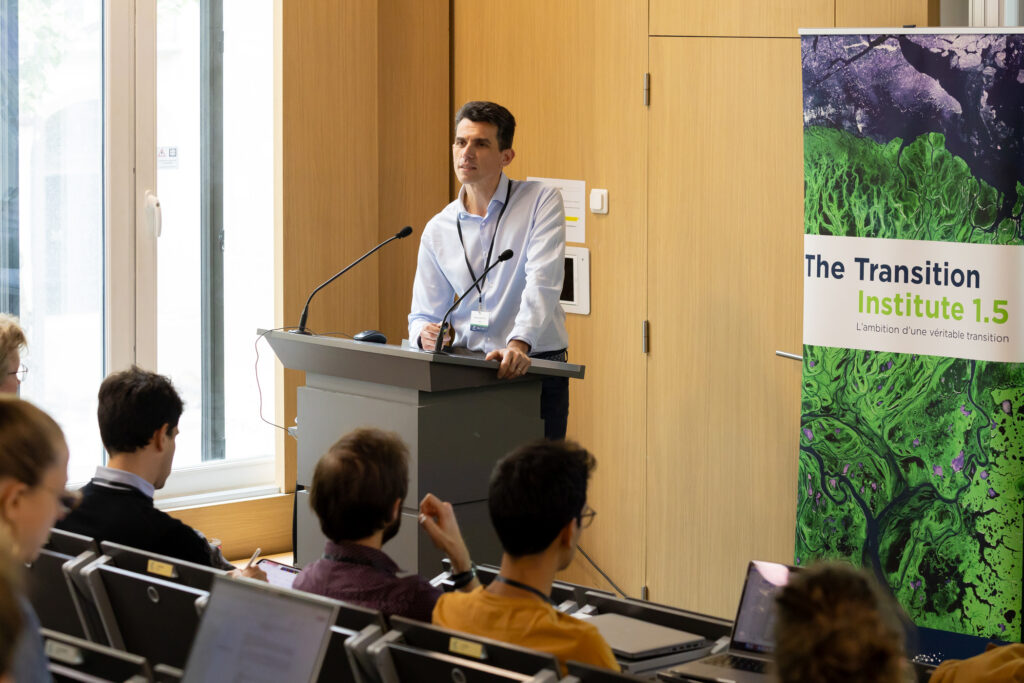Nature as the solution, data as the compass: making informed decisions in the face of climate change


During the workshop organized by TTI.5 on June 4, 2025, at Mines Paris – PSL, several research projects led by the School’s research centers were presented as part of a session dedicated to Theme 5. This article focuses on Emmanuel Garbolino, a researcher at the Higher Institute of Environmental Engineering and Management (ISIGE) at Mines Paris – PSL, and his ecological foresight project for robust Nature-based Solutions. This is an original contribution that sheds light on the conditions for an ecological transition that is attentive to living organisms.
In recent years, Nature-based Solutions (NbS) have attracted the attention of scientists, urban planners, and policy makers. But what exactly does this concept encompass?
[NbS refers to] actions aimed at protecting, sustainably managing, and restoring natural or modified ecosystems to directly address societal challenges in an effective and adaptive manner, while ensuring human well-being and producing benefits for biodiversity.
Three types of actions fall under this approach:
In concrete terms, this may involve greening urban areas, stabilizing riverbanks with local species, or creating green corridors to improve the resilience of territories to climate hazards. The challenge is twofold: responding to major societal challenges (adaptation to climate change, reduction of natural risks, etc.) while generating a net gain for biodiversity.

Ecosystem services—the benefits that nature provides us—are countless: water filtration, carbon storage, flood protection, pollination, and the provision of materials and food. Their economic value has been estimated by the OECD at around $130 trillion per year, which is more than the combined global GDP.
But these services are now under threat. Two major threats are weighing on them:
SfN relies on living materials—mainly plants—that must be able to adapt to new ecological conditions. However, with rising temperatures and changing precipitation patterns, many species can no longer find the conditions they need to thrive in their habitats. A plant chosen today to stabilize a slope may not survive tomorrow, compromising its ecological function and the expected benefits.
This is where Emmanuel Garbolino’s approach comes in: applying data science to ecological forecasting to design more resilient solutions that can withstand climate change.
The approach is based on characterizing the ecological niche of species, i.e., all the environmental conditions (temperature, humidity, soil type, etc.) that enable them to survive. By cross-referencing field observation data with statistical models, it is possible to assess a species’ ability to colonize a given space today—but also tomorrow, based on different climate scenarios.
These spatial distribution models not only enable the selection of species best suited to the local context, but also anticipate the likely movements or disappearances of species, and therefore the loss of associated services. Ultimately, this promotes better-informed decision-making upstream of restoration or development projects.
In 2022, an ecological restoration project (in collaboration with the company ASES and the Life Terra Foundation) was launched in an urban park in Nice, selecting plant species from nearby areas with a drier climate, such as certain regions of Spain. The aim is to ensure their survival in the face of future droughts while guaranteeing the expected ecosystem services. The result: more than 80% of the 4,000 plants tested were successfully established—a promising rate that confirms the value of the approach.

Emmanuel Garbolino’s work is not limited to theoretical modeling: it is embodied in concrete projects that illustrate TTI.5’s ability to bring different disciplines together to address complex ecological challenges. This is the case in the European project GE.CO, which explores the ecological rehabilitation of quarries in France and Italy. Here, models guide the choice of plant species and management methods according to local constraints.
But it is above all in the context of a thesis funded by TTI.5, led by Hanna Soto Vargas, that this approach comes into its own. The research aims to strengthen the resilience of river banks through SfN adapted to future climate and hydrological changes. It is based on a robust species selection method that integrates climate data, water conditions, and management issues.
The richness of the project lies in the close collaboration between disciplines at the crossroads of environmental sciences, ecological engineering, geosciences, and economics. Emmanuel Garbolino brings his expertise in data science and ecological forecasting to the project, joined by André Evette, researcher and engineer at INRAE and specialist in plant engineering, Sophie Guillon, lecturer and researcher at the Center for Geosciences at Mines Paris – PSL and expert in the dynamics of physical environments, and Pierre Fleckinger, director of the Center for Industrial Economics (CERNA) at Mines Paris – PSL and economist in charge of analyzing the costs associated with the proposed solutions.
By bringing these skills together within a single project, TTI.5 acts as a catalyst for scientific synergies, capable of producing concrete, rigorous and sustainable solutions. This interdisciplinary dynamic perfectly embodies the institute’s ambition: to put research at the service of an ecological transition rooted in the reality of the regions.
One of the major challenges of this approach is to make the results accessible and useful to field managers. This is why the tools developed allow for “downscaling,” i.e., fine-tuning the data to the local scale: municipality, plot, watershed, etc. This precision is essential for local authorities to be able to rely on concrete recommendations and avoid costly mistakes.
SfN are not miracle solutions, but they offer a promising way to link planning, resilience, and biodiversity. This requires a thorough understanding of the dynamics of living organisms, the complex interactions between species and environments, and robust tools for thinking about the future.